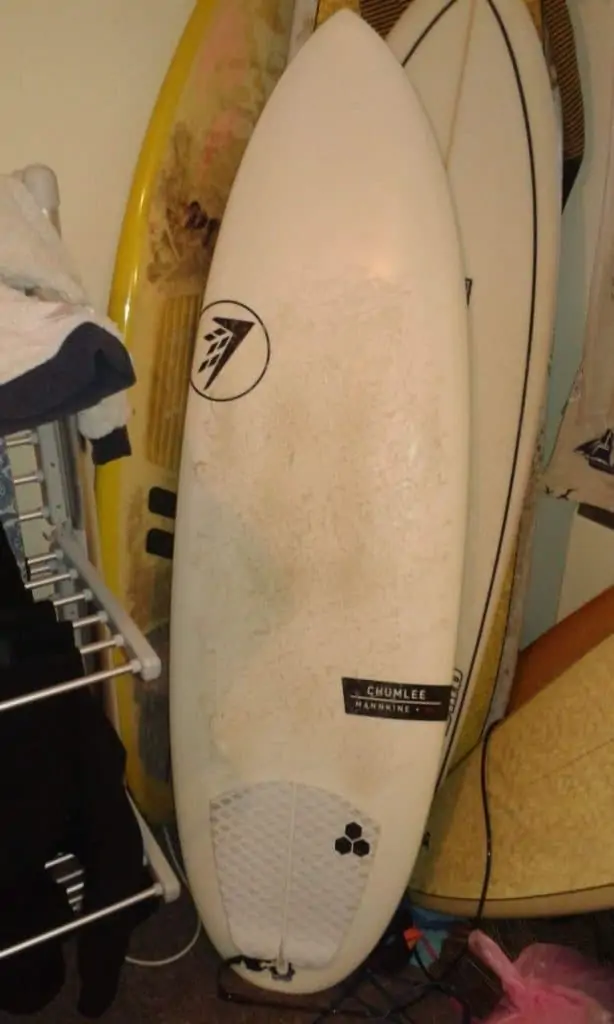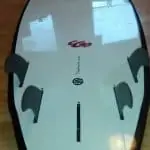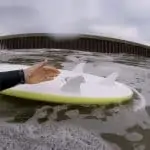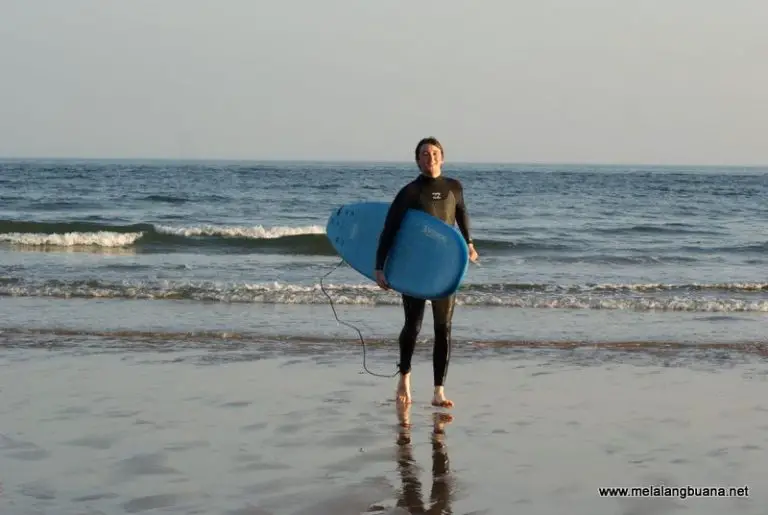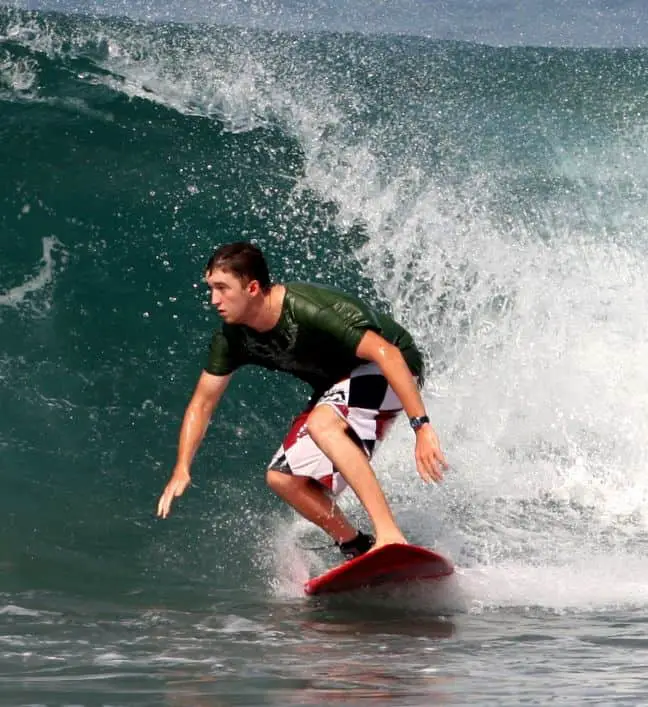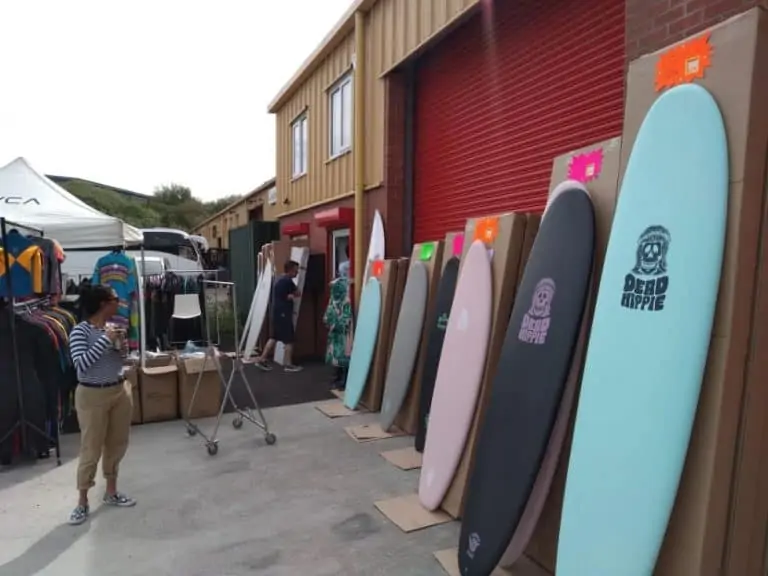Can You Surf Small Waves With a Shortboard?
Most of the time, we will find that we have to surf some smaller waves to keep things going.
Be it for lack of swell or just a lack of time, small waves are a part of surfing for all and getting out and riding them can be good fun.
However, small surf presents a few challenges for those riding shorter boards.
So, to answer a common question: can you surf small waves with a shortboard? Yes, you can but it gets more difficult the smaller the wave and the shorter the board. Expect to perform a limited number of tricks while surfing smaller waves on a shortboard. However, there are ways around this, as we’ll consider below.
Shortboard Size in Small Waves: Volume
The first big factor to think about when trying to ride small waves with a shortboard is the volume of your board.
The volume gives you an idea of how much float/buoyancy your board will have and is obviously relevant to your own height and weight. The more you weigh, the more volume you will need to get a shortboard going in small waves.
It takes a while to get an idea of the right kind of volume for you but try to take a note of the volume of each of the different boards you try along your way through learning to surf.
Although surfboard volume is quite a recent addition to product descriptions, most surfboard manufacturers now include this kind of information on the pages on their website or a surfboard’s Amazon listing to help buyers understand how much float each board will give.
The volume is particularly relevant in small waves since these waves have less push to them, meaning that your board will bog and feel slower than on bigger, more powerful waves. The lack of push means a lack of speed, which also makes riding small waves on a shortboard a challenging task.
If you already have a shortboard, have a look online to check the volume of that model. If you can’t find it, then look for shortboards with similar dimensions. If your board is from a local shaper, many of them take inspiration from the designs of the major surfboard shapers in the industry so you might find a similar design on the website of a big online surf shop with the volume given. Obviously, take this with a grain of salt since there will be some difference but if it’s mostly the same dimensions it should be within a couple of liters of the volume of your board.
It’s also possible to have a board with too much volume, meaning that you can barely turn it. Surfers refer to this kind of board as feeling “boaty” since it has the turning ability of a boat!
Shape of your Shortboard
Along with volume, you should also consider the shape of your shortboard.
Traditional shortboard templates have a very narrow nose and tail. Specifically, the lack of width in the nose of a surfboard means that it is harder to catch waves on, which again makes surfing small waves difficult.
Obviously, if you can’t catch the waves, then you can’t ride them!
This will also offer less float when you are up and riding so expect things to be more difficult on a narrower board. That said, these kinds of boards will turn faster on smaller spaces so there is a balance to be found there.
There is also a point to note here about the shape of a “shortboard”. Traditionally, shortboards were just as described above, narrow in the no see and tail and quite thin in the deck. This was considered great for pro surfers and good waves but never really suited intermediate surfers in average or small surf.
To that end, more and more shapes of surfboards have been designed in recent years in small sizes. You can see the FireWire Chumlee that I ride below with its rounded nose and wide useful, a shape that would have been inconceivable for most surfboard shapers in the early 2000s. However, given its 5’5 length but generous 33 liters in volume, this kind of fun shortboard template allows for a heck of a lot more fun in the small stuff than any standard shortboard would.
So, if you are willing to try boards that might look “alternative”, you may well find that you open things up for a heck of a lot more fun in the surf, I know I’ve certainly benefited from doing so.
Flatter Shortboards
Another point is that shortboards that are flatter will perform better in small surf. The lengthways curve in a surfboard is called the ‘rocker’, and surfboards have this both in the nose and the tail.
Small wave shortboards will be designed to be flatter to have more of a planing surface to help the rider get into a wave and generate speed.
Older surfboards used to be quite flat but then, in the early 90s and until recently, shortboards went through a phase of having lots of rocker. This made them faster to turn but much harder to paddle and generate speed from. Fortunately, today there is a trend back in the direction of flatter boards that suit the majority of surfers, but just the pros and advanced level riders.
So, in terms of choosing a shortboard for the small stuff, flatter is most definitely better as you will catch more waves and generate speed much more easily, so it’s a no-brainer really.
Construction
You can also get a little more float from a shortboard by using a different construction. Most standard shortboards are made with a polyurethane (PU) foam template that has been covered in a fiberglass cloth and resin.
However, given that there is constant innovation in surfing, there are more and more alternative constructions available with some offering more float than the standard fiberglass PU shortboard.
The first kind that comes to mind is an ‘EPS’ foam surfboard, short for ‘expanded polystyrene’. This means that the blank at the center of the surfboard is lighter which helps the board to float better given the lack of weight. Going for a shortboard with this kind of construction can give you a boost in smaller waves.
Taking the construction a step further, you can opt for an entirely epoxy surfboard without a stringer at all, as there’s offer even more buoyancy and are extremely durable.
I had a red Santa Cruz Pumpkin Seed surfboard for several years that was 6’2 and approximately 32 liters in volume. It floated me extremely well and paddled into waves super early thanks to its wide nose and flatter rocker. The epoxy construction added a buoyancy that I’d not experienced before and my wave count went through the roof as a result. As an added bonus, it also felt bulletproof and did not have a single pressure doing after me using it heavily for 3 years.
However, the downside to pure epoxy construction shortboards is that they do feel a little less responsive in turns than standard fiberglass surfboards so you might find them a little harder to turn quickly in the small stuff.
In fact, the reason I sold my Santa Cruz shortboard was because I wanted to work on doing sharper, faster turns, something which I felt I couldn’t do on that board, although I had a ton of fun on it while I had it.
Quad Fins
Going for a shortboard that has quad fin options can help to generate a little more speed in small surf.
This is because the lack of a center fin, as is standard in the usual 3-fin thruster set up on shortboards, means that the board has less drag in a key area and pushes along the wave a touch quicker.
The only downside to quad fins is that they are a little bit looser (i.e. slidey) in turns that thrusters so you won’t have the same tight turning arc although you will have more speed to play with.
As a safe option, look for a shortboard that has 5 fin options so that you can switch between thruster and quad options to see how they both go in tiny surf.
I have several boards with these options and, as mentioned above, I use a Chumlee as my go-to small wave shortboard. With this having a wide, rounded tail, I’ve found that quad fins alone make it feel a little hard to control while a thruster 3-fun set up feels a little slow. Through experimenting, my preferred small wave fin set up is now a quad set up with a tiny trailer fun the center fin position.
This gives the best of both worlds: speed of a quad with similar control to a thruster. Not many people use this out in the surf but I’d highly recommend it if you can get the fins.
I use the Middle Finger 2 fin from Futures Fins as my trailer, but you can get the Knubster trailer fin if you have FCS fin boxes; the latter was used by Kelly Slater in a pro surf competition in New York where he got to the final in, admittedly, very good waves. Still, don’t rule it out until you’ve tried it!
What to Expect
If you go out to surf tiny waves with a shortboard, you should expect to catch fewer waves than normal since they will be harder to catch.
You should also expect to perform fewer maneuvers, mainly because the lack of the speed from the waves you catch will mean that you really have to work harder and turn faster to get your board to do what you want it to do.
That said, expect to have a lot of fun as there are usually far fewer people out when the surf is small so it’s a good chance to focus on things like your pop-up, fitness and agility without too many distractions in the form of other people out in the line up.
Best options
So, to round up, and as we’ve looked at above, the best kind of shortboard for small surf is one that has more volume than your usual surfboard for good waves, and has a flatter rocker. Also experiment with 5 fin options if possible.
Don’t be afraid of going for an alternative template here as you can have a heck of a lot of fun in a board that some might not consider a “true” shortboard.
In fact, I currently ride a 5’5 FireWire Chumlee board in small waves. I’m 6’0 and weigh 180 pounds (78kg), plus a few extra pounds in winter with all the heavy gear. This board floats me extremely well and helps me catch all kinds of waves on small days and has been a great addition to my quiver.
For am further info, as always, the guys from the YouTube channel How to Rip have some good tips and advice on the topic, as you can see in the video below:
Related Questions
What is riding waves on a shortboard called? Shortboarding is the term often used for surfing waves with this kind of board. Although not an official verb in the dictionary, most surfers would use this often, or as part of the phrase ‘go shortboarding’ if talking about a change of board.
In a similar vein, riding a longboard is normally called ‘longboarding’, so nobody will bat an eyelid if you use the term.
How long should a beginner surfboard be? 2 feet longer than you are tall is a good size for this. This should give you plenty of options to learn on. That said, think about shape and volume, too.
You do not want a board that is long but extremely thin and lightweight as this won’t really help, so look for a board with a generous template and outline.
To see more specifics on this, be sure to check out my helpful guide on choosing the right beginner surfboard for you.
